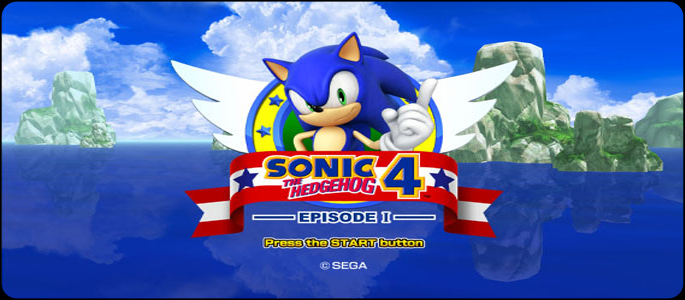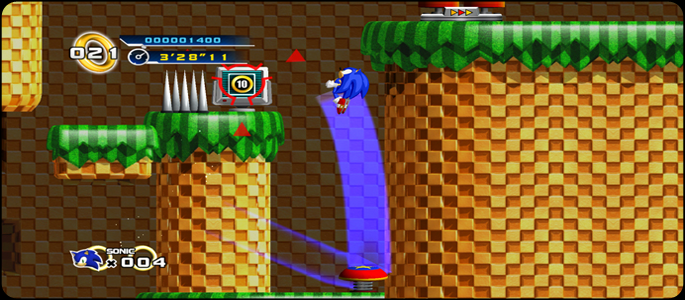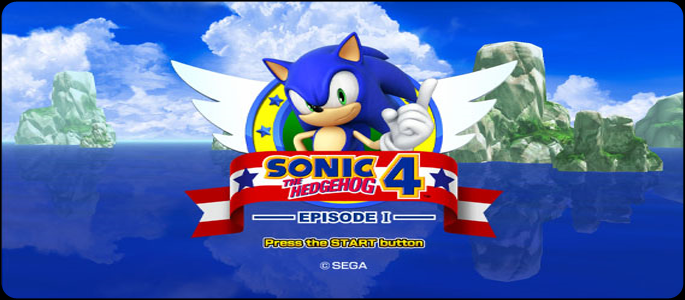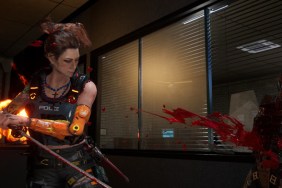
The time has finally come. It has been over fifteen years since the last installment in the original Sonic The Hedgehog time-line, and we now have a true sequel in the form of Sonic The Hedgehog 4: Episode I on the PlayStation Network. Has Sega managed to restore that old-school feel that originally made Sonic so great? Let’s find out.
We’ll start off with the visuals. If there’s one category where this game scores big, it’s this one; Sonic 4 is absolutely gorgeous. Each one of the seventeen stages (including boss battles) are beautifully crafted to resonate an old-school feel with a current-gen makeover. The water effects and backdrops are all redone and beautifully rendered. Also, the added effects in each stage don’t appear cheap at all, as is sometimes the case when 2D franchises make the jump to HD. Now, the visuals look fantastic, but the real downside comes in the form of originality.
Now, I’m not one to pick on a game for not being original; after-all, this is Sonic, and most of the levels, at least in structure, are likely to appear somewhat similar to one-another, no one can argue that. But the issue is that all the levels in Sonic 4 are essentially carbon copies of the levels found in Sonic 1 and Sonic 2, with absolutely zero originality, save for the mine cart and torch portions of Lost Labyrinth zone. Even the theme when each act starts are dead-on identical to past iterations, which might lead one to believe that Sega execs just saw Sonic 2 as the pinnacle of perfection and commanded that the developers “make a game like that!” This robs Sonic 4 of it’s identity, since the game lacks any defining moments, both visually and audibly. Additionally, every enemy in Sonic 4 is an enemy that has appeared in either Sonic 1 or Sonic 2. Yep, not one new badnik in the whole bunch. The developers could have at least put forth an effort to include some sort of new enemies, especially with the new gameplay additions, but no, nothing.

Then comes the sound. The music in Sonic 4 is bright and cheery, nearly all the time, with very little variety to be had. Now, there’s nothing wrong with happy music, but this game lacks most of the whimsical or even adrenaline fuelled musical styles that stood out in the earlier games. By the time you make it through Casino Street (roughly halfway through the game), you’re more than likely to get a little aggravated, as the same musical style is used in just about every act up to that point. Luckily, this changes by the time you hit Lost Labyrinth, and continues to get better as the game progresses. If you’re a real Sonic connoisseur, then you’ll notice that nearly all the sound effects in Sonic 4 are comprised of sounds originating from Sonic 1 all the way up to the Sonic Adventure series; this may seem like another copy-cat effort, but the old-school fans might enjoy it.
Now it’s time to get into the real ‘meat and potatoes’ of Sonic 4 – the gameplay. Sega took a unique approach when tackling the style and pacing of the game by introducing players to Sonic’s all-new homing attack. When playing, anything (enemies, springs, power-ups, etc.) within Sonic’s homing range will light up with a reticule, letting the player know that Sonic can engage it with a homing attack. These attacks can be chained together for point multipliers in addition to helping Sonic progress through levels and gain access to new areas.

Speaking of pace, that’s one thing that really suffers in this game as a result of Sonic’s homing attack and new running/jumping style. I’m sorry to say that momentum (what Sonic was basically founded on) is all but non-existent now. The days of building up speed or relying on speed to help get you over that next obstacle appear to be gone. This hurts the overall pace of the game, as Sonic’s spin-dash no longer has the ability to help Sonic gain momentum and speed when charging through loops and down slopes. This, coupled with the excessive need to use the homing attack, really slows down the experience and may be a turn-off for some. That being said, if you’re good enough with the homing attack, it is possible to springboard through a level with some serious speed, but one wrong step or missed button press will stop you dead in your tracks, the somewhat unresponsive controls don’t help this.
And oh yeah, that thing called gravity? That’s not really present either. Not only is Sonic’s jump much slower this time around (almost as though he’s floating, or jumping on the moon), but there comes times when you shouldn’t be able to make it up a ninety degree slope without momentum (that’s gone, remember?), however you can do it anyway by just holding forward with minimal speed, even if you’re running upside-down. So, although new gameplay styles are being explored and implemented, there is still significant room for improvement. It really is a darn shame that the game ends when it does, because Mad Gear Zone is pretty darn fun, and the final boss battle is great, essentially the only real challenge in the game aside from collecting chaos emeralds. Hopefully the ending momentum carries over to episode II.
Players can expect the standard single-player mode, along with a time-attack mode, both of which have online leaderboard support. Remember the special stages from Sonic 1? Yeah, those are back as well, but with a twist that makes them slightly irritating, yet still amusing. Even with the franchise’s speed reduced, and physics that are all but non-existent, there’s still a mildly entertaining platformer to be found within. Those who are new to the Sonic series, or are just looking for a game to shoot through in under 2 hours will find a good bit of fun here. However, those who have played past iterations of Sonic, preferably the Genesis classics, should proceed with caution, as many of the things that made Sonic great are absent in this latest outing, not to mention the $15 price tag is somewhat steep for a game served up across several episodes.
PlayStation LifeStyle’s Final Score
– Lack of originality creates a “been there, done that” sensation. – Abstract physics, or lack thereof, can make gameplay frustrating. |
 |




